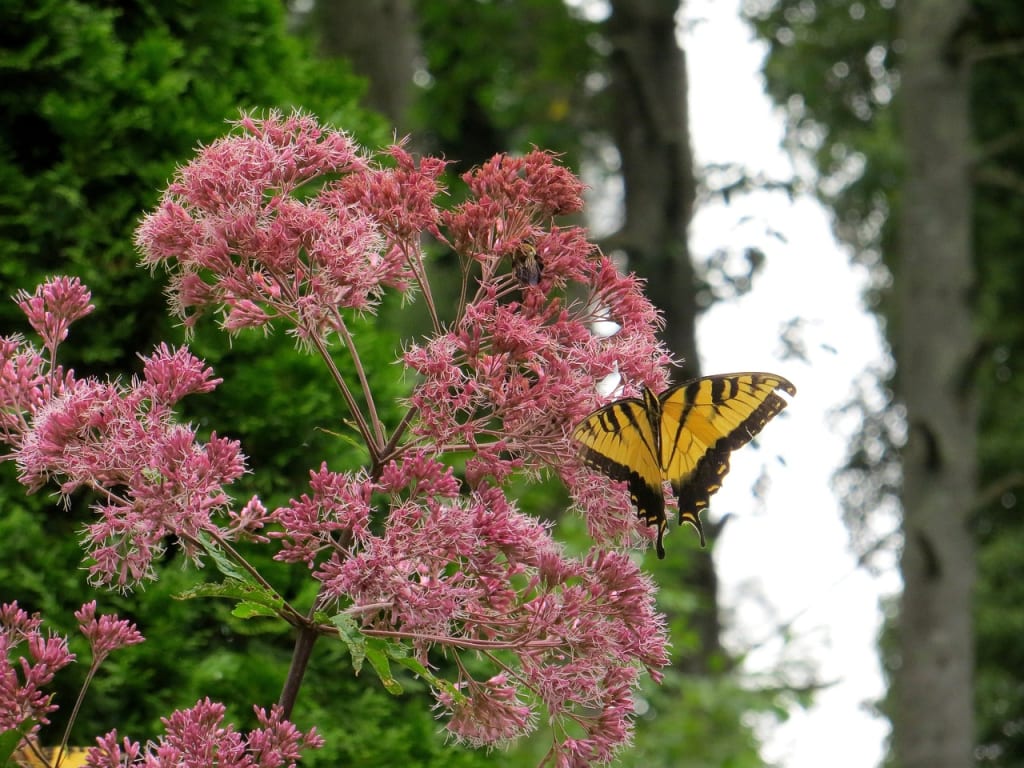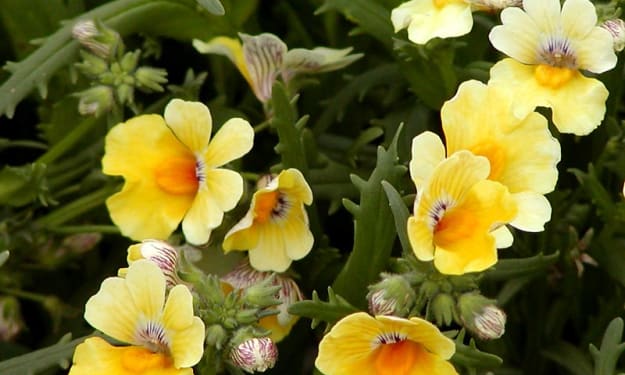Joe Pye Weed 101: Guide to Growing & Caring
Eutrochium purpureum

Joe Pye weed (Eutrochium purpureum) is a beautiful perennial that adds beauty and charm to any garden or landscape. With its tall stature, clusters of pinkish-purple flowers, and ability to attract pollinators, it has become a favorite among gardeners.
Joe Pye weed belongs to the family Asteraceae, scientifically known as Eutrochium purpureum, and is a perennial flowering plant native to eastern North America. It is named after a Native American herbalist, Joe Pye, who reportedly used the plant to treat various ailments.
Joe Pye weed typically grows in moist, wet soils, often along stream banks, marshes, and meadows. It can reach heights of 4 to 7 feet (1.2 to 2.1 meters) and has large, domed clusters of pinkish-purple flowers that bloom from mid-summer to early fall. The flowers attract butterflies, bees, and other pollinators, making them popular for wildlife gardens and naturalistic landscapes.
Choosing the Right Location
Consider Sunlight Requirements: While Joe Pye weed can tolerate some shade, it thrives in full sun to partial shade. Aim to plant it in a location that receives at least six hours of direct sunlight daily. However, if you live in a region with hot summers, providing some afternoon shade can help protect the plant from excessive heat and prevent wilting.
Assess Soil Moisture: Joe Pye weed prefers consistently moist soil, so selecting a location with adequate moisture levels is crucial. Look for an area where the soil naturally retains moisture or where you can easily supplement it with regular watering. Avoid areas with poorly drained soil or locations prone to waterlogging, leading to root rot and other issues.
Consider Soil pH: Joe Pye weed is adaptable to various soil pH levels but prefers slightly acidic to neutral soil. Aim for a pH level between 6.0 and 7.5 for optimal growth. If you're unsure about your soil's pH, use a soil testing kit available at most garden centers. Adjust the pH by adding amendments such as sulfur for more acidic soil or lime for more alkaline soil if necessary.
Also Read: Guide to Growing Hellebore Flowers
Evaluate Space and Growth Habit: Joe Pye weed can grow quite tall, ranging from 4 to 7 feet (1.2 to 2.1 meters), depending on the variety. Consider the plant's mature size and choose a location where it will have ample space to grow without overcrowding other plants or structures. This will allow it to spread its beautiful foliage and flower clusters freely.
Consider Surrounding Plants: Consider the companion plants around Joe Pye weed. It pairs well with other tall perennials or ornamental grasses, creating a visually appealing and diverse landscape. Ensure the surrounding plants won't compete for resources or excessively shade the Joe Pye weed.
Wildlife Considerations: Joe Pye weed is known for its attractiveness to butterflies, bees, and other pollinators. If you're explicitly planting it to attract wildlife, consider locating it near other nectar-rich plants or water sources, such as a pond or bird bath. This will create a favorable environment for pollinators to visit and enhance biodiversity in your garden.
Planting Joe Pye Weed
- Timing: The ideal time to plant Joe Pye weed is in the spring or early fall when the weather is mild. This allows the plant to establish its roots before the harsh summer or winter conditions. Avoid planting during periods of extreme heat or cold.
- Preparing the Planting Hole: Prepare the soil in the designated area before planting. Dig a hole twice the width and depth of the plant's root ball. This provides ample space for the roots to spread out and establish themselves.
- Soil Amendment: While Joe Pye weed is relatively adaptable to different soil types, adding organic matter such as compost can improve its structure, drainage, and nutrient content. Mix the organic matter with the soil to create a loose and fertile planting bed.
- Planting Depth: Place the Joe Pye weed plant in the prepared hole, ensuring that the top of the root ball is level with or slightly above the surrounding soil surface. Avoid planting too deeply, as this can lead to root suffocation or rot.
- Backfilling and Soil Firming: Backfill the hole with the amended soil, gently firming it around the roots. Keep the soil tight enough, as this can hinder root growth. Ensure that the plant is stable and upright after backfilling. After planting, thoroughly water the Joe Pye weed to settle the soil and provide initial hydration to the roots.
- Mulching: Apply a layer of organic mulch around the base of the plant, leaving a small gap around the stem to prevent rotting. Mulch helps conserve soil moisture, suppress weeds, and regulate soil temperature. Use wood chips, straw, or shredded leaves, and replenish the mulch as needed.
- Spacing: Joe Pye weed plants require adequate air circulation and growth spacing. Follow the specific spacing recommendations for the variety you are planting, typically allowing around 2 to 4 feet (0.6 to 1.2 meters) between plants, depending on their mature size.
- Staking: If you anticipate that the tall stems of your Joe Pye weed may require support, it's best to stake or install plant supports early in the growing season. This helps prevent the plants from toppling due to wind, rain, or weight. Place the stakes carefully to avoid damaging the roots.
- Post-Planting Care: Continue monitoring the soil moisture regularly and water as needed after planting. Be patient, as the plant may take a few weeks to establish itself and show new growth. Remove any weeds that compete for resources, but take care not to disturb the shallow root system of the Joe Pye weed.
Joe Pye Weed Care
Watering
Joe Pye weed prefers consistently moist soil, especially during its active growing season. Water the plant regularly, aiming for about 1 inch (2.5 cm) of water per week. Adjust the watering frequency based on weather conditions, ensuring the soil remains evenly moist but not soggy. Mulching around the plant helps retain moisture and reduce weed competition.
Soil Fertility
While Joe Pye weed can tolerate various soil conditions, it benefits from fertile soil. In early spring, apply a balanced, slow-release fertilizer according to the manufacturer's instructions. Avoid excessive nitrogen, as it can lead to leggy growth. Organic compost or well-rotted manure can also be incorporated into the soil to improve fertility.
Also Read: Growing and Maintaining Hydrangea Plants
Pruning
Pruning helps maintain the plant's shape, encourages bushier growth, and prevents it from becoming too tall and floppy. In late winter or early spring, prune the plant back to a height of 6 to 8 inches (15 to 20 cm) before new growth emerges. This stimulates vigorous growth and promotes robust flowering. Remove any dead or damaged stems throughout the growing season.
Support
Tall varieties of Joe Pye weed may require support to prevent flopping under the weight of their flower clusters. Stake or install plant supports, such as bamboo stakes or metal rings, early in the season before the stems become too tall and heavy. Secure the stems to the support structure using soft ties or garden twine, taking care not to constrict their growth.
Division and Propagation
Over time, Joe Pye weed forms dense clumps, which can benefit from division every few years. Dividing the plant helps manage its size, rejuvenates older sections, and promotes healthier growth. Divide the clumps in early spring or late fall when the plant is dormant. Ensure each division has sufficient roots and shoots before replanting them in well-prepared soil.
Pest and Disease Control
Joe Pye weed is generally not prone to severe pest or disease issues. However, look for common garden pests like aphids or Japanese beetles, and address them promptly using organic pest control methods. Good garden hygiene, such as removing dead foliage and providing adequate airflow, can help prevent diseases like powdery mildew.
Winter Care
Established Joe Pye weed plants are generally hardy and require minimal winter care. Leave the dried flower heads intact during winter to provide visual interest and food sources for birds. Mulch around the base of the plant to protect the roots from freezing temperatures. Consider applying a thicker layer of mulch in areas with severe winters for added insulation.
Wildlife Habitat
Joe Pye weed is a pollinator magnet, attracting butterflies, bees, and other beneficial insects to your garden. Embrace its role in supporting wildlife and ecological diversity by incorporating other native plants and creating a habitat-friendly garden. Avoid using pesticides and provide additional water sources to enhance its appeal to pollinators.
Conclusion
Caring for Joe Pye weed is not just a task but an opportunity to immerse yourself in the enchanting world of nature. As you tend to its needs, you'll witness the plant's remarkable growth, from the emergence of vibrant green shoots to the graceful sway of its majestic flower clusters. The vibrant pinkish-purple blooms will become a haven for butterflies and bees as they dance among the petals, spreading life and color throughout your garden.
So, embrace the joy of caring for Joe Pye weed and let it serve as a reminder that even the simplest acts of gardening can awaken a sense of wonder and appreciation for the wonders of our planet.
👉 Do you have any additional insights or questions? We highly value your feedback. Please share your thoughts by leaving a comment below.
Join today to share and publish your content on Vocal Media and earn money.
About the Creator
Amir Hossain
I blog on everything and anything— hoping my blogs will make your days a bit happier!






Comments
There are no comments for this story
Be the first to respond and start the conversation.